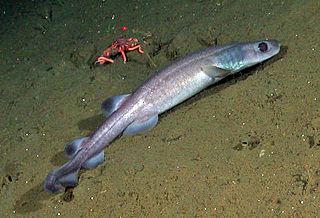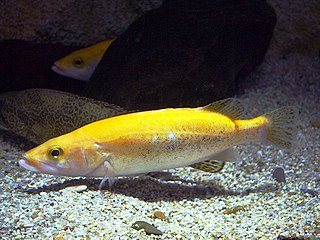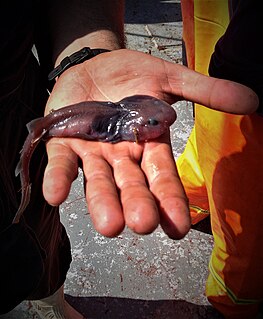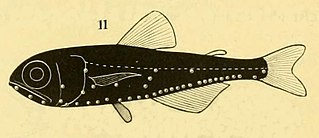 W
WAlbatrossia pectoralis, the giant grenadier or giant rattail, is a very large rattail, and the only member of the genus Albatrossia. It is found in the north Pacific from northern Japan to the Okhotsk and Bering Seas, east to the Gulf of Alaska, and south to northern Baja California in Mexico. It is found at depths between 140 and 3,500 m. It can grow up to 2.1 m in length. The giant grenadier has the usual greatly elongated, pointed tail of the rattails.
 W
WArgyrocottus zanderi is a species of sculpin native to the northwestern Pacific Ocean from Japan to the Kuril Islands and in the Sea of Japan. It is found at depths of from 0 to 85 metres. This species grows to a length of 9 centimetres (3.5 in) SL. This species is the only known member of its genus.
 W
WThe bayou killifish or bayou topminnow is a topminnow-like fish that thrives primarily in the shallow waters off the shores of the Americas, as well as fresh and brackish waters. Feeding off of small vertebrates and invertebrates, this fish displays reproduction techniques unique to its species.
 W
WThe blackish stingray, Hemitrygon navarrae, is a little-known species of stingray in the family Dasyatidae, found in the northwestern Pacific Ocean off the coasts of mainland China and Taiwan. This species reaches 38 cm (15 in) across and has a chocolate brown, diamond-shaped pectoral fin disc nearly as long as wide. Its whip-like tail bears three large tubercles in front of the stinging spine, as well as both dorsal and ventral fin folds with the ventral fold half as long as the disc. Caught as bycatch in bottom trawls, the blackish stingray is frequently marketed as food in China. The International Union for Conservation of Nature (IUCN) does not yet have sufficient information to assess the conservation status of this species.
 W
WThe blackspot shiner is a species of freshwater fish in the family Cyprinidae. It is endemic to the United States and found in the lower Brazos River drainage of eastern Texas east to the Calcasieu River drainage of southwestern Louisiana and the Red River drainage of southeastern Oklahoma, southwestern Arkansas, and northwestern Louisiana. It grows to 7.6 cm (3.0 in) total length.
 W
WThe brown catshark is commonly found in the Pacific Ocean, ranging from the northern Pacific waters off the coast of British Columbia and south to the Baja California peninsula in Mexico. They may live as far south as Ecuador and Peru. Brown catsharks are deep-water sharks that live on the outer continental shelf and the upper slope. They have been known to live at depths ranging from 30 to 650 m and live on the bottom, usually in muddy or sandy areas. The brown catshark, when originally described, was called Catulus brunneus.
 W
WThe Chihuahua shiner is a species of freshwater ray-finned fish from the family Cyprinidae, the carps and minnows. It is found in southern Texas and northern Mexico.
 W
WThe Chilean devil ray, also known as the box ray, greater Guinean mobula, sicklefin devil ray or the spiny mobula, is a species of ray in the family Mobulidae. It is found worldwide in tropical, subtropical and warm temperate oceans, and mainly occurs offshore, only occasionally appearing near the coast. These fish have been discovered to feed at depths up to 1,848 metres (6,063 ft) during deep dives, and are among the deepest-diving ocean animals. There are two distinct deep dive patterns; the first, which is usually only performed once every 24 hours, is diving to the maximum depth and resurfacing after 60 to 90 minutes; the second, which is less frequent, is dives up to 1,000 meters for a maximum of 11 hours. The latter pattern may be associated with traveling rather than feeding. It can reach a disc width of up to 3.7 m (12 ft).
 W
WThe Chilean eagle ray is a species of fish in the family Myliobatidae. Found off the coasts of Chile and Peru, its natural habitat is open sea.
 W
WThe filetail catshark is an Eastern Pacific endemic deepwater catshark ranging from Oregon to the Gulf of California. Adults are epibenthic and found near areas of rocky vertical relief over soft mud bottoms on the outer continental shelf and upper slope at depths of 91 to 1,251 m, juveniles are mesopelagic, found around 500 m off the bottom in waters over 1,000 m deep. They have been seen at the Lasuen Knoll during ROV expeditions at roughly 300 m deep. Reaches a maximum size of 60 cm TL. An oviparous species, females deposit eggcases throughout the year with concentrated reproductive output July through September. There is no information available on the age and growth, longevity, fecundity, abundance or mortality of this species. It is not targeted by commercial fisheries or utilized for human consumption, but is known to be incidental catch in longline and bottom trawl fisheries, although no specific data is available.
 W
WThe golden mandarin fish, also known as the leopard mandarin fish, is a species of freshwater ray-finned fish, an Asian perch from the family Sinipercidae, which is native to eastern Asia. This species can reach at least 33.4 cm (1.1 ft) in standard length and 607.3 g (1.34 lb) in weight. It is typically yellowish-brown with blackish-brown speckles ("leopard"), but there are also bright yellow ("golden") individuals, which are particularly prized in Korea and selectively bred in captivity.
 W
WThe California golden trout, or simply the golden trout (Oncorhynchus aguabonita or Oncorhynchus mykiss aguabonita), is a species of trout native to California. The golden trout is normally found in the Golden Trout Creek, Volcano Creek, and the South Fork Kern River. It is the state freshwater fish of California.
 W
WThe lollipop catshark is a little-known species of deep sea catshark, belonging to the family Scyliorhinidae, and the only described member of its genus. A diminutive, bottom-dwelling shark of the outer continental shelf and upper continental slope, this species can be readily identified by its tadpole-like shape with a greatly expanded, rounded head and narrow body. The large head houses expanded gills, which are thought to be an adaptation for hypoxic conditions. This shark preys on crustaceans and fishes. Reproduction is aplacental viviparous, with females retaining egg cases internally two at a time until they hatch. There is no fishery interest in this species, and the International Union for Conservation of Nature (IUCN) lacks sufficient information to assess its conservation status.
 W
WLoweina rara is a species of lanternfish.
 W
WMyctophum affine, the Metallic lanternfish, is a species of lanternfish native to the Atlantic Ocean. This species grows to a length of 7.9 centimetres (3.1 in) SL.
 W
WMyctophum phengodes, the Bright lanternfish, is a species of lanternfish.
 W
WThe California golden trout, or simply the golden trout (Oncorhynchus aguabonita or Oncorhynchus mykiss aguabonita), is a species of trout native to California. The golden trout is normally found in the Golden Trout Creek, Volcano Creek, and the South Fork Kern River. It is the state freshwater fish of California.
 W
WPangio doriae is a species of ray-finned fish in the genus Pangio.
 W
WPercopsis transmontana, the Sand roller, is a species of percopsiform fish endemic to the Columbia River drainage in the northwestern United States. This species grows to a length of 9.6 centimetres (3.8 in) TL. Sand rollers can live up to 6 years in slow-moving, sandy-bottomed streams and rivers among vegetation. Their diet includes flies and Trichoptera, although juveniles also have been known to eat crustacean zooplankton.
 W
WPungtungia herzi is a species of cyprinid fish found in Japan and the Korean Peninsula.
 W
WThe pygmy whitefish is a freshwater whitefish of the genus Prosopium in the family Salmonidae. Found in the mountain streams and lakes in western North America, it also has isolated populations in Lake Superior and in Ekityki Lake, Chukchi Peninsula.
 W
WRhinopias frondosa, the weed fish, or popeyed scorpionfish, is a benthic marine fish which belongs to the family Scorpaenidae or also known as the Scorpionfishes family.
 W
WThe ribbon shiner is a species of freshwater fish of the cyprinid genus Lythrurus and is native to the United States.
 W
WThe Sakhalin sturgeon is a species of fish in the family Acipenseridae. It is found in Japan and Russia.
 W
WScleropages jardinii, the Gulf saratoga, Australian bonytongue or Northern Saratoga, is a freshwater bony fish native to Australia and New Guinea, one of two species of fishes sometimes known as Australian arowana, the other being Scleropages leichardti. It has numerous other common names, including northern saratoga, toga and barramundi. It is a member of the subfamily Osteoglossinae, a (basal) teleost group. Its scientific name is sometimes spelled S. jardini.
 W
WStegastes leucorus, commonly known as the whitetail damselfish, the whitetail gregory or the whitetail major, is a damselfish of the family Pomacentridae. It is native to the tropical eastern Pacific Ocean.
 W
WToxotes blythii, the clouded archerfish or zebra archerfish, is a perciform fish of genus Toxotes. It is found in rivers and estuaries in Myanmar, ranging from the lower Irrawaddy to the Tenasserim Division, including lower Sittaung and Salween. Unlike some other archerfish, it is restricted to fresh water. This species was formerly thought to be identical to T. microlepis. However, differences in structure and colouration caused the splitting of T. blythii into a new species. It is sometimes seen in the aquarium trade, but is generally rare.
 W
WWarming's lantern fish, Ceratoscopelus warmingii, is a lanternfish of the family Myctophidae, found circumglobally in both hemispheres, at depths of between 700 and 1,500 m during the day and between 20 and 200 m at night. Its length is about 8 cm (3.15 in).
 W
WThe Zvonimir's blenny is a species of combtooth blenny found in the Mediterranean and Black Sea. This species reaches a length of 7 centimetres (2.8 in) TL. The identity of the person honoured in the specific name is uncertain but is thought to be the Medieval King of Croatia and Dalmatia Demetrius Zvonimir who reigned from 1075-1089 probably in allusion to the area where the type was collected.